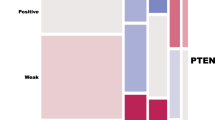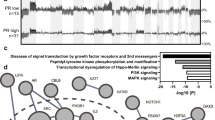Abstract
In 73 CAP-1 treated stage III and IV ovarian cancers, the prognostic significance of morphometric features and cellular DNA content has been evaluated in comparison with histologic type, grade of differentiation and a number of clinical characteristics. Borderline tumours were excluded from the study. Median follow-up was 44 months, median survival time 36 months. Single features associated with prognosis were (in order of decreasing significance according to single variate analysis): FIGO stage (P = 0.0002), bulky disease (P = 0.004), standard deviation and mean of nuclear area (P = 0.0006 and P = 0.01), cellular DNA content (P = 0.01), mitotic activity index (P = 0.08) and volume percentage epithelium (P = 0.13, not quite significant). Tumours with a mean nuclear area greater than 70 micron2 (which occurred in 35% of the cases) were nearly all aneuploid. Multivariate analysis showed that the statistically most significant prognostic combination of features consisted of mean nuclear area, presence or absence of bulky disease and FIGO stage (in order of decreasing importance) (Mantel-Cox = 23.07, P less than 0.00001). A low value for the multivariate function of this combination of features was associated with a poor prognosis within 24 months, a high value with a favourable outcome. Another favourable combination of features appeared to be diploid cellular DNA content and a low mitotic activity index (11 patients, one died). However, even with the prognostically most favourable combination of these features, several patients died. Of all combinations of features investigated, only two were associated with an excellent prognosis (low mitotic activity index and low volume percentage epithelium). Cancers of 7 patients (10%) displayed such features, and none of them died during the follow-up period (minimally 20 and maximally 54 months). It is concluded that morphometric and flow cytometric analysis can provide significant and objective information to predict the prognosis of cis-platin-treated advanced ovarian cancer patients.
This is a preview of subscription content, access via your institution
Access options
Subscribe to this journal
Receive 24 print issues and online access
$259.00 per year
only $10.79 per issue
Buy this article
- Purchase on Springer Link
- Instant access to full article PDF
Prices may be subject to local taxes which are calculated during checkout
Similar content being viewed by others
Author information
Authors and Affiliations
Rights and permissions
About this article
Cite this article
Baak, J., Schipper, N., Wisse-Brekelmans, E. et al. The prognostic value of morphometrical features and cellular DNA content in cis-platin treated late ovarian cancer patients. Br J Cancer 57, 503–508 (1988). https://doi.org/10.1038/bjc.1988.114
Issue Date:
DOI: https://doi.org/10.1038/bjc.1988.114
This article is cited by
-
DNA topoisomerase IIα and -β expression in human ovarian cancer
British Journal of Cancer (1999)
-
Prognostic value of nuclear morphometry in patients with TNM stage T1 ovarian clear cell adenocarcinoma
British Journal of Cancer (1999)
-
How malignant is malignant? A brief review of the microscopic assessment of human neoplasms, and the prediction of whether they will metastasize and kill
Clinical & Experimental Metastasis (1991)



